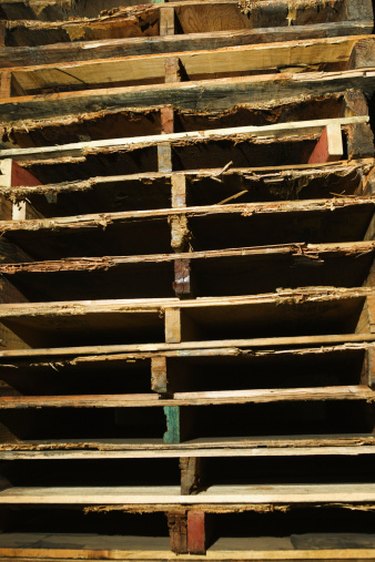
Wooden pallets make up a large part of the wood container industry. According to the U.S. Economic Census of 2007, wooden pallets make up almost 60 percent of the wooden containers produced in the U.S. However, these containers are losing ground to plastic pallets for four major reasons.
Deterioration
Video of the Day
After wooden pallets are used several times, the wood begins to wear. It splinters, cracks and even breaks under the pressure of continued use. The deterioration is natural and occurs eventually, even if the wood is treated to repel moisture and to strengthen it. This disadvantage leads to replacement much sooner than with plastic pallets.
Video of the Day
Infestation
Wooden pallets are more susceptible to infestation by termites, ants and other insects that make their home inside the wood. Pallets stored outdoors are more likely to succumb to infestation than the ones kept within a warehouse. The insects burrow into the wood, eating away at it and thus weakening what should be a support structure. Wooden pallets can also carry pathogens that can contaminate the products that are carried on them. According to an American Broadcasting Company's report on food pallets, the bacterium E.coli, salmonella and listeria were found on pallets in a Louisiana plant. These pathogens could potentially infect tons of food or medical products stored on the pallets for shipping.
Cleanliness
In addition to germs, wooden pallets are collectors of dirt and debris. Cleaning them becomes more and more difficult over time as the pallets age. They must be heat-treated to get rid of the contamination and washed to be rid of of dirt and debris. However, the heat accelerates deterioration, and the water, if improperly dried, can feed mold spores that thrive on wood.
Cost
Wood pallets are inexpensive but must be replaced several times before plastic pallets even begin to show age. John Clark, technical sales director of the Nelson Company, states in "Pallets 101: Industry Overview and Wood, Plastic, Paper & Metal Options" that plastic pallets cost three to six times more per pound than wood pallets. However, Supply Chain Digest's "Wood Versus Plastic Pallet Battle Increasingly Focused on Green Supply Chain" states that plastic pallets have a life of 15 years, while wood pallets are expected to last only three years in the same conditions and with proper care and maintenance. Thus, plastic pallets are much more cost-effective than wooden pallets in the long run.
- U.S. Census Bureau: Wooden Container and Pallet Manufacturing
- Intelligent Global Pooling Systems: Setting the New Standard in Sustainable Pallet Rental
- Replas Plastic Recycling Solutions: Food Distribution Using Slipsheets
- American Broadcasting Company News: Food Safety Plastic vs. Wood Pallet Wars
- The Nelson Company: Pallets 101: Industry Overview and Wood, Plastic, Paper & Metal Options; John Clark
- Supply Chain Digest: Logistics News: Wood Versus Plastic Pallet Battle Increasingly Focused on Green Supply Chain